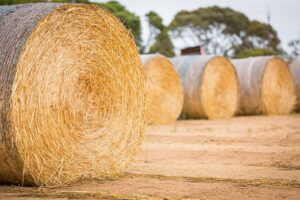In agriculture, where efficiency and sustainability are paramount, the role of baling twine cannot be overstated. Used primarily to bind together hay or straw into compact, manageable bales, baling twine is a humble yet indispensable tool for farmers. However, not all baling twines are created equal, such as the UV-resistant baling twine. One key characteristic that sets certain varieties apart is UV resistance, a feature that adds a layer of durability and versatility to this essential farm implement.
Baling twine, also known as bale twine or hay twine, is a type of cord bundling together harvested crops. Typically made from synthetic materials like polypropylene or polyethylene, baling twine is chosen for its strength, flexibility, and resistance to environmental factors. However, relentless exposure to sunlight can take a toll on traditional twines, leading to degradation and reduced effectiveness over time.
 Enter UV-resistant baling twine – a game-changer in the agricultural landscape. UV resistance refers to the twine’s ability to withstand the damaging effects of ultraviolet (UV) rays from the sun. This feature is particularly crucial for baling twine, given its extended exposure to sunlight during the baling process and subsequent hay or straw bales storage.
Enter UV-resistant baling twine – a game-changer in the agricultural landscape. UV resistance refers to the twine’s ability to withstand the damaging effects of ultraviolet (UV) rays from the sun. This feature is particularly crucial for baling twine, given its extended exposure to sunlight during the baling process and subsequent hay or straw bales storage.
UV-resistant baling twine is treated with additives that protect against the harmful effects of UV radiation. This treatment enhances the twine’s lifespan and preserves its tensile strength and integrity. As a result, farmers can expect their bales to remain securely bound, even after prolonged exposure to sunlight.
The versatility of UV-resistant baling twine extends beyond its primary function of binding bales. Farmers and agriculturalists have discovered innovative ways to leverage this durable twine across various aspects of farm life.
- Fencing Solutions:
UV-resistant baling twine has proven to be an excellent material for temporary fencing solutions on farms. Its strength ensures that it can withstand the elements, making it a reliable choice for creating enclosures for livestock or protecting specific farm areas.
- Garden and Plant Support:
In smaller-scale agriculture or home gardening, UV-resistant baling twine is helpful in supporting plants. Whether securing young saplings to stakes or creating trellises for climbing plants, the twine’s strength and durability make it a practical choice for gardeners looking for a long-lasting solution to their plant support needs.
- Repairing and Securing Equipment:
Farm equipment often faces wear and tear, especially in the demanding agricultural environment. UV-resistant baling twine comes to the rescue as an impromptu repair tool. Whether patching up a torn tarp, securing loose parts, or even temporarily fixing a broken gate, this versatile twine can be a quick and effective solution to keep operations running smoothly.
- Crafting and DIY Projects:
Beyond the farm, UV-resistant baling twine has found a place in crafting and do-it-yourself (DIY) projects. Its toughness and resistance to environmental factors make it a reliable choice for creating outdoor decorations, woven mats, or even rustic furniture.
Farmers should consider factors such as the twine’s tensile strength, thickness, and colour options when selecting UV-resistant baling twine. The appropriate choice depends on the farm’s specific requirements, the type of crops being baled, and the intended use beyond the baling process.
Opting for a UV-resistant twine with a high tensile strength ensures that it can endure the pressure exerted during baling without compromising the integrity of the bales. Thickness is another critical factor that influences the twine’s overall durability. Farmers must balance thickness and flexibility to ensure ease of use during the baling process.
Additionally, the colour of the UV-resistant baling twine can have practical implications. While colour may seem like a cosmetic consideration, it can affect the twine’s visibility in the field, making it easier for farmers to manage and locate bales.
UV-resistant baling twine stands as a testament to the continuous innovation in agriculture, addressing the specific challenges faced by farmers in the field. Its durability, versatility, and resistance to the damaging effects of UV rays make it an invaluable tool that goes beyond the traditional role of bale binding. As farmers continue to seek sustainable and efficient solutions, UV-resistant baling twine remains a shining example of how a small design tweak can significantly benefit the agricultural landscape. With its ability to withstand the test of time and adapt to diverse applications, UV-resistant baling twine proves that even the simplest tools can play a pivotal role in the modern farm’s success.